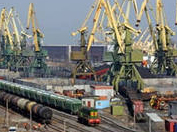Baltic ports record growth of cargo turnover, mostly due to Russian export cargoes
 Active development of Russian ports does not prevent Baltic states from gradually increasing their harbor capacities – cargo turnover growth exceeds 10% a year. New capacities in the ports are built by Russian investors who focus on favorable operating conditions, European service, developed automobile and railway networks.
Active development of Russian ports does not prevent Baltic states from gradually increasing their harbor capacities – cargo turnover growth exceeds 10% a year. New capacities in the ports are built by Russian investors who focus on favorable operating conditions, European service, developed automobile and railway networks.
GROWING TRAFFIC
Latvian ports and railroads recorded growth of cargo turnover in 2012, Latvian Transport Minister Aivis Ronis told RBC Daily at the annual Baltic Forum in Riga. "He said that 90% of cargoes were coming to us from Russia and Belorussia, and 10% were going in the opposite direction. Russian coal, fertilizers, grain and petroleum products are transshipped mainly through Latvian ports. "In the future we want to handle more containers," added the minister. There are already prerequisites for this. In one of the largest Baltic Free Port of Riga, which in 2011 handled 34 million tons of cargo (+11.8%), the Russian National Container Company plans to build a container terminal to handle 540 thousand TEU per year. For this purpose, the company has leased a 160-hectare plot of land. The investments in the project are estimated at $200 mln.
The Latvian Railway is steadily increasing its cargo traffic. According to LZD President Ugis Magonis, a cargo train crosses the border with Russia every 20 minutes. As a result, in 2011 the railway transported 59 million tons of cargo, of which 20 million tons of Russian coal.
Since December 2008, a terminal for transshipment of coal from the mine "Zarechnaya" in Kuzbass, with capacity of 6 million tons of coal per year, operates in the port of Ventspils. In the near future construction of the second stage of the terminal will start, and it will be able to handle 10.5 mln tons of coal. For comparison, a coal terminal for 12.5 million tons was built in the port of Ust-Luga. There are also terminals in Ventspils to transship potash with a capacity of 7.5 million tons per year, and a terminal to transship grain, serving exports from Russia and Kazakhstan with capacity of 1.5 million tons per year.
RTL company is going to expand its presence in Ventspils. Now it operates a multifunctional terminal located on the territory of 30 hectares and handles container and ro-ro cargoes. In 2011 the company leased another 100 hectares of land in the so-called Northern Port. Deputy Manager of Ventspils port Guntis Drunkka told that the Russian company plans to build a container terminal, a complex for car transshipment and a site for bulk cargoes on this land. "The approximate scheme of the terminals location has been worked out and RTL is searching for a third investor to start the project," specified Mr. Drunkka.
THERE'S ENOUGH TO GO AROUND
Russian business willingly works in Latvia due to favorable location in the Baltic Sea - Liepaja and Ventspils are ice-free ports which do not require icebreaker escort in winter. Depth of the water area allows to accommodate ships with maximum draft, which can pass through the Danish straits. It is also important that the ports work as special economic zones and provide tax benefits. For example, in the ports of Riga and Ventspils an investor initially does not pay property tax, and most goods are not subject to VAT.
The Baltic states are not afraid of competition with Russian ports. Guntis Drunkka believes that despite the active development of Ust-Luga and St. Petersburg ports, Russian cargoes will be enough for everyone. It is impossible to take all Russian cargoes from Baltic ports, agrees Alexander Goloviznin, Deputy Director General of Ust-Luga Company. "There is competition, there is an international division of labor, including logistics, and all the advantages of logistics are just in diversity and diversification," he notes. According to Mr. Goloviznin, there are a number of Russian companies which initially built their logistics on the Baltic ports and built terminals there. Transshipment volumes continued to grow this year as well. In the first quarter of 2012 the Latvian Railway has already transported 25 million tons of cargo. The forecast for shipments in 2012 is 65 million tons. The port of Ventspils handled 11.8 million tons (+21% compared with the previous year). Cargo turnover in Riga during the quarter amounted 12.52 mln tons (+14.89%). All six ports of Lithuania, Latvia and Estonia handled 38.4 million tons of cargo (+58%) in the first quarter of 2012.

 EN
EN PL
PL EE
EE








